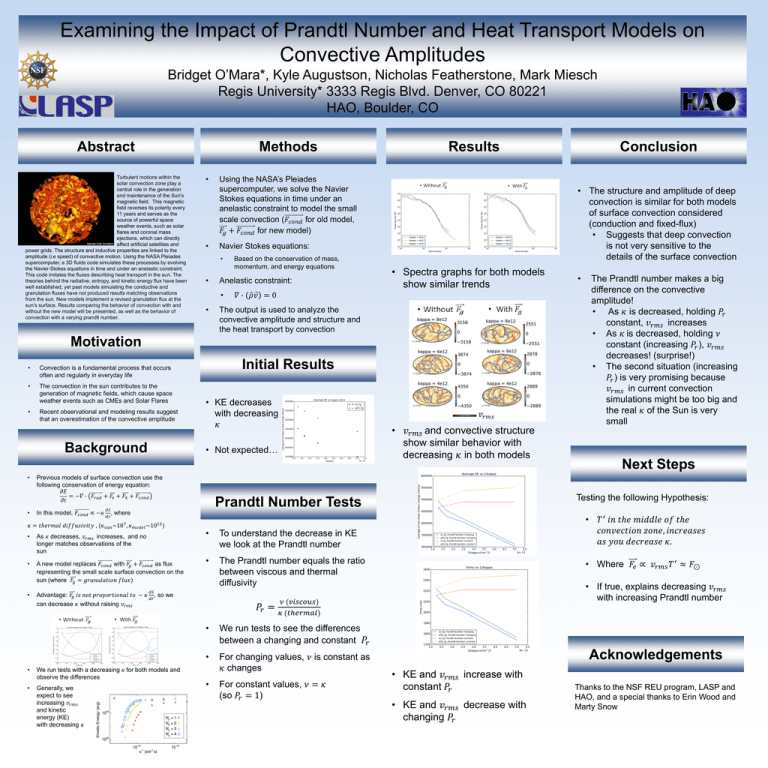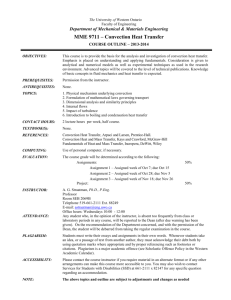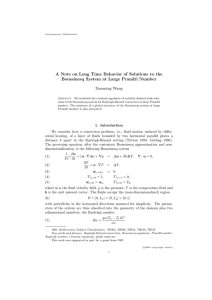Examining the Impact of Prandtl Number and Heat Transport Models... Convective Amplitudes
advertisement

Examining the Impact of Prandtl Number and Heat Transport Models on Convective Amplitudes Bridget O’Mara*, Kyle Augustson, Nicholas Featherstone, Mark Miesch Regis University* 3333 Regis Blvd. Denver, CO 80221 HAO, Boulder, CO Abstract Methods Turbulent motions within the solar convection zone play a central role in the generation and maintenance of the Sun's magnetic field. This magnetic field reverses its polarity every 11 years and serves as the source of powerful space weather events, such as solar flares and coronal mass ejections, which can directly affect artificial satellites and power grids. The structure and inductive properties are linked to the amplitude (i.e speed) of convective motion. Using the NASA Pleiades supercomputer, a 3D fluids code simulates these processes by evolving the Navier-Stokes equations in time and under an anelastic constraint. This code imitates the fluxes describing heat transport in the sun. The theories behind the radiative, entropy, and kinetic energy flux have been well established, yet past models simulating the conductive and granulation fluxes have not produced results matching observations from the sun. New models implement a revised granulation flux at the sun’s surface. Results comparing the behavior of convection with and without the new model will be presented, as well as the behavior of convection with a varying prandtl number. • • Using the NASA’s Pleiades supercomputer, we solve the Navier Stokes equations in time under an anelastic constraint to model the small scale convection (𝐹𝑐𝑜𝑛𝑑 for old model, 𝐹𝑔 + 𝐹𝑐𝑜𝑛𝑑 for new model) Anelastic constraint: • • Based on the conservation of mass, momentum, and energy equations • Spectra graphs for both models show similar trends 𝛻 ∙ 𝜌𝑣 = 0 The output is used to analyze the convective amplitude and structure and the heat transport by convection Motivation • Convection is a fundamental process that occurs often and regularly in everyday life • The convection in the sun contributes to the generation of magnetic fields, which cause space weather events such as CMEs and Solar Flares • Recent observational and modeling results suggest that an overestimation of the convective amplitude Background • • • Not expected… Previous models of surface convection use the following conservation of energy equation: 𝜕𝐸 = −𝛻 ∙ 𝐹𝑟𝑎𝑑 + 𝐹𝑒 + 𝐹𝑘 + 𝐹𝑐𝑜𝑛𝑑 𝜕𝑡 In this model, 𝐹𝑐𝑜𝑛𝑑 ∝ −𝜅 𝑑𝑆 , 𝑑𝑟 • 𝑣𝑟𝑚𝑠 and convective structure show similar behavior with decreasing 𝜅 in both models • As 𝜅 decreases, 𝑣𝑟𝑚𝑠 increases, and no longer matches observations of the sun Prandtl Number Tests • A new model replaces 𝐹𝑐𝑜𝑛𝑑 with 𝐹𝑔 + 𝐹𝑐𝑜𝑛𝑑 as flux representing the small scale surface convection on the sun (where 𝐹𝑔 = 𝑔𝑟𝑎𝑛𝑢𝑙𝑎𝑡𝑖𝑜𝑛 𝑓𝑙𝑢𝑥) • To understand the decrease in KE we look at the Prandtl number • The Prandtl number equals the ratio between viscous and thermal diffusivity • We run tests with a decreasing 𝜅 for both models and observe the differences • Generally, we expect to see increasing 𝑣𝑟𝑚𝑠 and kinetic energy (KE) with decreasing 𝜅 𝑃𝑟 = We run tests to see the differences between a changing and constant 𝑃𝑟 • For changing values, 𝜈 is constant as 𝜅 changes • For constant values, 𝜈 = 𝜅 (so 𝑃𝑟 = 1) Next Steps • Where 𝐹𝑒 ∝ 𝑣𝑟𝑚𝑠 𝑇 ′ ≈ 𝐹⊙ • If true, explains decreasing 𝑣𝑟𝑚𝑠 with increasing Prandtl number 𝜈 (𝑣𝑖𝑠𝑐𝑜𝑢𝑠) 𝜅 (𝑡ℎ𝑒𝑟𝑚𝑎𝑙) • The Prandtl number makes a big difference on the convective amplitude! • As 𝜅 is decreased, holding 𝑃𝑟 constant, 𝑣𝑟𝑚𝑠 increases • As 𝜅 is decreased, holding 𝜈 constant (increasing 𝑃𝑟 ), 𝑣𝑟𝑚𝑠 decreases! (surprise!) • The second situation (increasing 𝑃𝑟 ) is very promising because 𝑣𝑟𝑚𝑠 in current convection simulations might be too big and the real 𝜅 of the Sun is very small • 𝑇 ′ 𝑖𝑛 𝑡ℎ𝑒 𝑚𝑖𝑑𝑑𝑙𝑒 𝑜𝑓 𝑡ℎ𝑒 𝑐𝑜𝑛𝑣𝑒𝑐𝑡𝑖𝑜𝑛 𝑧𝑜𝑛𝑒, 𝑖𝑛𝑐𝑟𝑒𝑎𝑠𝑒𝑠 𝑎𝑠 𝑦𝑜𝑢 𝑑𝑒𝑐𝑟𝑒𝑎𝑠𝑒 𝜅. 𝑑𝑆 Advantage: 𝐹𝑔 𝑖𝑠 𝑛𝑜𝑡 𝑝𝑟𝑜𝑝𝑜𝑟𝑡𝑖𝑜𝑛𝑎𝑙 𝑡𝑜 − 𝜅 , so we 𝑑𝑟 can decrease 𝜅 without raising 𝑣𝑟𝑚𝑠 • Testing the following Hypothesis: where 𝜅 = 𝑡ℎ𝑒𝑟𝑚𝑎𝑙 𝑑𝑖𝑓𝑓𝑢𝑠𝑖𝑣𝑖𝑡𝑦 , (𝜅𝑠𝑢𝑛 ~107 , 𝜅𝑚𝑜𝑑𝑒𝑙 ~1012 ) • Initial Results • KE decreases with decreasing 𝜅 Conclusion • The structure and amplitude of deep convection is similar for both models of surface convection considered (conduction and fixed-flux) • Suggests that deep convection is not very sensitive to the details of the surface convection Navier Stokes equations: • • Results Acknowledgements • KE and 𝑣𝑟𝑚𝑠 increase with constant 𝑃𝑟 • KE and 𝑣𝑟𝑚𝑠 decrease with changing 𝑃𝑟 Thanks to the NSF REU program, LASP and HAO, and a special thanks to Erin Wood and Marty Snow






